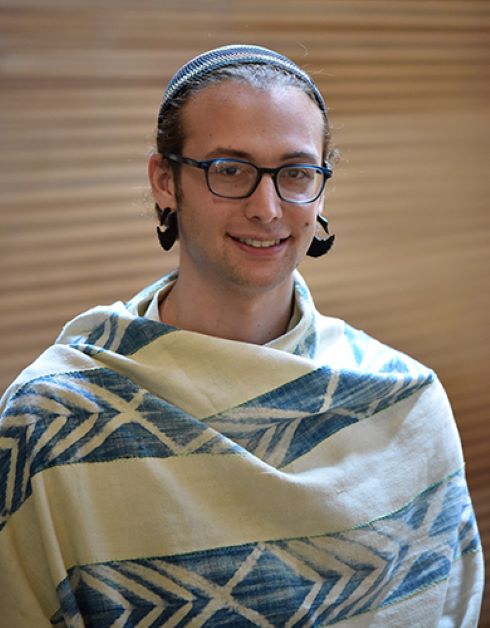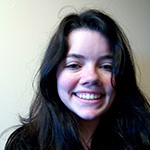The LGBTQ Jewish Anthology
March 8, 2018
By Violet Fearon
 There is a tendency to closely associate LGBTQ identities with the modern era, as enormous strides in visibility and acceptance have been made in the past few decades. This was certainly Noam Sienna's experience: growing up in a "very accepting Jewish community" in Toronto, he felt welcome, but also "like my identity as a queer Jew was seen as innovative or novel."
There is a tendency to closely associate LGBTQ identities with the modern era, as enormous strides in visibility and acceptance have been made in the past few decades. This was certainly Noam Sienna's experience: growing up in a "very accepting Jewish community" in Toronto, he felt welcome, but also "like my identity as a queer Jew was seen as innovative or novel."
This world view was turned upside-down when, while an undergraduate at Brandeis, Sienna attended a talk by Peter Cole on his book, "The Dream of the Poem: Hebrew Poetry from Muslim and Christian Spain" (Princeton University Press, 2007). After Cole discussed the medieval homoerotic poetry of Jewish scholars like Yehuda haLevi and Shmuel haNagid, Sienna was struck by the sudden possibility that there was a vast history of LGBTQ Jewish topics that had been neglected or obscured in his own Jewish education; he wanted "to learn about Jewish history in a way that respected all the facets of my identity.”"
A decade later, Sienna — now a doctoral candidate in Jewish history at the University of Minnesota — is publishing a groundbreaking work with the support of the Hadassah-Brandeis Institute, tentatively titled: "The LGBTQ Jewish Anthology: a Reader of Primary Sources from the Talmud to Stonewall." Over his years of research, Sienna has shifted from a simple desire to share these primary historical sources with others to a hope that they will serve as "raw material for further work."
But "The LGBTQ Jewish Anthology" is not meant just for academia. Sienna hopes "people will take all the stories in this book and use them to write other books and articles, incorporate them into college courses or classroom activities, design summer camp programs or synagogue lectures with them, make films and write poems and paint pictures about them."
The entries in "The LGBTQ Jewish Anthology" are varied; about one third of them have never before been published in English. In totality, they form a collection of documents relating to a wide variety of same-sex relationships and homoerotic desires, transitions between and across gender identities, and ambiguity in how bodies are gendered. As an example, Sienna relates a particularly compelling entry: the story of Esther/Jacques, the first recorded Jew in Canada. Born Esther Brandeau in early 18th-century France, as a teenager they chose to live as Jacques La Fargue, a Christian boy. After traveling around Europe, Esther/Jacques reached present-day Quebec; but when their birth identity was revealed (and they refused to convert to Christianity), Esther/Jacques was deported back to France.
The story of Esther/Jacques reveals the uncertainty inherent in exploring these texts. As Sienna explains, "one way to read this source would be through a trans lens, looking at Esther/Jacques as someone who understood themselves to be a different gender than they were assigned at birth. Another way would be to imagine why else Esther/Jacques might have chosen to live as a man: to pursue marriage or partnership with a woman? To seek new professional, economic, or social opportunities? To leave a restrictive or oppressive family life? Some combination of all the above? All these readings are possible, and they can all co-exist."
A tempting question arises: which interpretation is the truth? But Sienna steers us away from that line of thought, and towards a more complex perspective. "I'm not suggesting that I know the 'true' story of Esther/Jacques' life," says Sienna, "but I do believe that reading their story alongside our own contemporary experiences and identities adds a richness and depth that had been previously ignored."
In "The LGBTQ Jewish Anthology," Sienna has assembled a rich historical exploration of the intersection between Jewish and LGBTQ identities. His work documents the persecution faced by LGBTQ Jews (multiple entries concern individuals who died in concentration camps, who not only faced harsh treatment from Nazis, but were socially ostracized by other prisoners; other entries document the execution of Jews convicted of sodomy by the Inquisition, and the difficulties faced by gay and lesbian American Jews in the McCarthy Era), but also the outpouring of creativity which emerged from this pain. The many examples of poetry, drama, memoir, art, and midrash presented in the book all celebrate the richness of LGBTQ Jewish identity, and the important (and unacknowledged) role that LGBTQ lives and experiences have played throughout Jewish history around the world.
More personally, Sienna himself views his own queer identity as "inseparable" from his Jewish identity. Being queer and Jewish have both directed him in similar ways: "towards a social orientation that pays particular attention to individuals and communities left marginalized and vulnerable; towards an appreciation of ancestry and family, both biological and chosen; and towards building a safer and more loving world for all people."
Sienna's anthology will be published in the fall of 2018 through Print-O-Craft Press, but pre-orders will begin within the next few months.
Learn more about the HBI Research Awards.
 Violet Fearon, a freshman and Humanities Fellow, is the HBI student blogger.
Violet Fearon, a freshman and Humanities Fellow, is the HBI student blogger.
Noam Sienna, Brandeis ’11, is a Jewish educator, artist, and doctoral candidate in Jewish history at the University of Minnesota. His anthology of LGBTQ Jewish history is slated for publication in 2018. He received a 2016 HBI Research Award in their newest category, LGBTQ Studies.